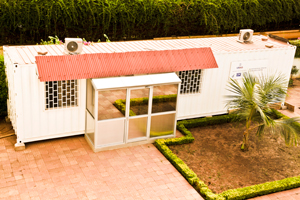The team developed an innovative solution to this dilemma – they converted a 40 x 8 foot shipping container into an insectary-in-a-box.

The insectary-in-a-box is a cost-effective and quick solution to carry out entomological monitoring under difficult field conditions. Source: Abt Associates
The insectary is divided into three rooms: one for keeping adult mosquitoes; one for rearing mosquitoes from larvae; and one for completing morphological identification, dissection, and susceptibility testing. The insectary is outfitted with air conditioners and humidifiers to maintain optimal conditions for the mosquitoes.
While the insectary-in-a-box was originally developed in response to a crisis, the insectary can be used for several years. “Months after its establishment, a large number of mosquitoes are reared and maintained in the insectary, which means this is an optimum environment for rearing mosquitoes,” said the project’s technical director. Since the insectary-in-a-box is mobile, it could be relocated so that another organization could sustain the insectary after the current project ends.
In countries that do not have an insectary, the insectary-in-a-box model can serve as a quickly implementable, cost-effective solution to carry out entomological monitoring that ultimately results in improved quality of IRS.
